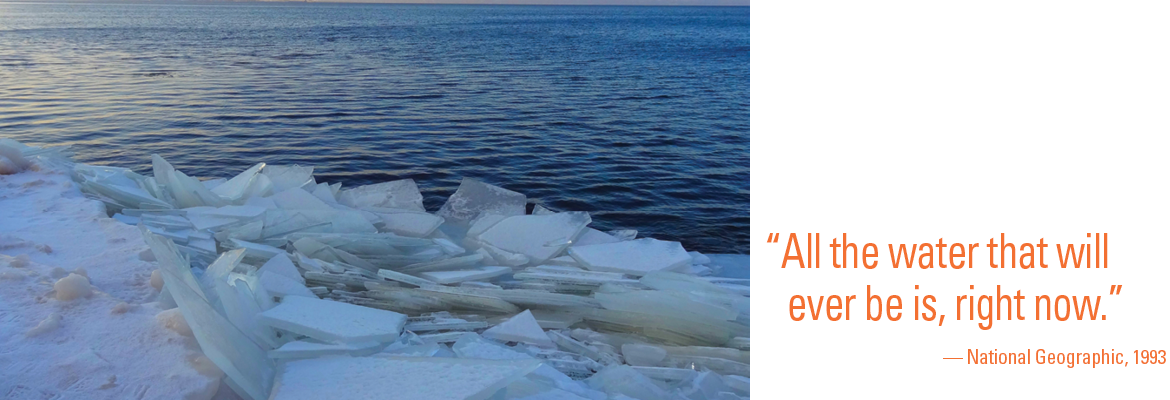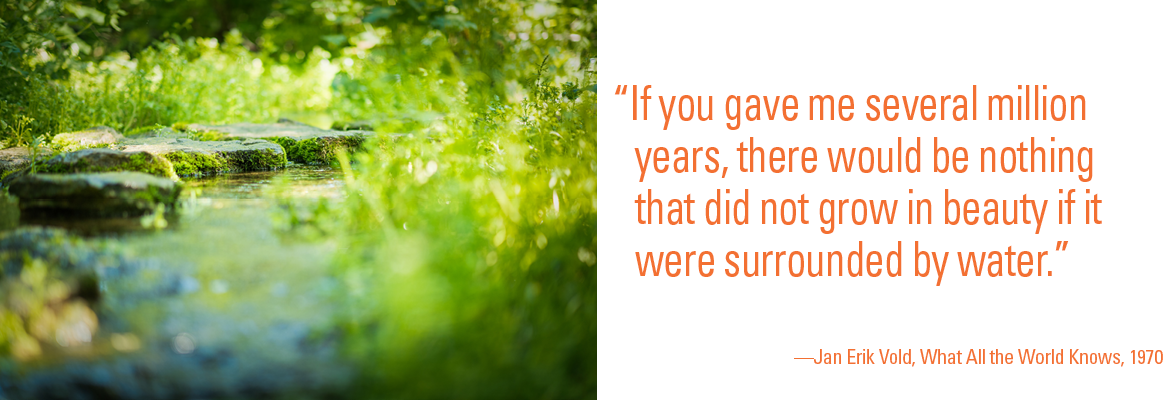
Fresh Waters
Just 3 percent of the world’s water exists as fresh water—2 percent is locked in the polar ice caps; less than 1 percent resides in freshwater lakes and streams.
The Great Lakes contain an estimated 5,500 cubic miles (22,700 cubic kilometers) of water—a fifth of all the liquid surface fresh water on Earth.
The United States draws more than 40 billion gallons (151 million liters) of water from the Great Lakes every day—half of which is used for electrical power production.
Wisconsin Waters
About 6.4 million acres (2.6 million hectares) of lakes Michigan and Superior and 95,000 acres (38,445 hectares) of the Upper Mississippi River lie within Wisconsin’s borders.
Wisconsin has more than 15,000 lakes and 13,500 miles (21,700 kilometers) of navigable streams and rivers.
Almost 3 percent of Wisconsin’s area—nearly a million acres (405,000 hectares)—is lakes.
Wisconsin has about 1.2 million billion gallons (4.5 million billion liters) of water underground—if it were above ground, it would submerge the state in 100 feet (30 meters) of water.
Nearly one-third of prehistoric, post-glacial Wisconsin was wetlands. Nearly half of the estimated 10 million acres of pre-settlement wetlands have been lost.
Wisconsin’s 11 coastal counties contain more than 1.2 million acres of wetlands (486,000 hectares)—nearly a fourth of all of the state’s remaining wetlands. The wettest is Marinette County with nearly 228,000 acres (92,000 hectares).

Waterways and Byway
Wisconsin has more than 800 miles (1,300 kilometers) of Great Lakes coastline and nearly 200 miles (325 kilometers) of Mississippi River shoreline.
There are 2,444 trout streams in Wisconsin—put end to end, they would stretch more than 956 miles (1,540 kilometers).
With 28 lakes, the Eagle River chain of lakes is the largest in the world.
More than a third of Wisconsin’s population lives in the 11 counties forming its Lake Michigan coast; 24 percent live in the three southeast coastal counties of Milwaukee, Racine and Kenosha.
Wisconsin has more than 500,000 registered motorboats—about one for every 10 residents.
Anglers net about 67 million fish a year from Wisconsin waters, including more than 500,000 Great Lakes trout and salmon.
At least 160 non indigenous aquatic species have colonized Great Lakes waters—more than half of them since the opening of the St. Lawrence Seaway in 1959.
Wisconsin’s power and water utilities spend about $5 million annually trying to protect water intakes from zebra mussels.
Highly Valued Assets
The assessed value of Lake Michigan lake-shore property in just one Wisconsin county—Door County—is almost $2 billion.
Each year, Wisconsin’s 12 active harbors on lakes Michigan and Superior handle a total of more than 40 million tons (40 billion kilograms) of commodities valued at more than $7 billion.
Wetlands and abundant high-quality water make Wisconsin the nation’s top producer of cranberries and 10th-largest producer of trout.
The Wisconsin Department of Natural Resources (DNR) sells more than 1,000,000 resident and 500,000 nonresident recreational fishing licenses annually, collecting more than $1.1 billion in fees. DNR estimates that those anglers spend another $2.1 billion in Wisconsin communities each year.
Thirsty People—and Cows
Wisconsin uses an average of 56 gallons (212 liters) of water per day per person from public water supplies and private wells. The national per capita average is 90 gallons (341 liters) a day.
Wisconsin has 1.4 million dairy cows, each of which needs to drink 45 gallons (170 liters) of water a day to produce 100 pounds (45 kg), or 12 gallons (45 liters), of milk.
Wisconsin public water utilities draw about 600 million gallons (2.3 billion liters) of water per day. The state’s 642 wastewater facilities release about the same amount of treated water daily.
Water Power
Wisconsin uses a total of more than 7 billion gallons (26.5 billion liters) of water per day—about 80 percent of it for thermoelectric power production.
Wisconsin’s 50 fossil fuel power plants use nearly 4 billion gallons (15 billion liters) of water per day. The state’s two nuclear power plants use about 2 billion gallons (7.5 billion liters) daily.
Almost all of the water used for thermoelectric power production in Wisconsin comes from surface sources.
Wisconsin has more than 200 hydroelectric generator units, which produce a total of 1.6 million kilowatt-hours of electricity.
Water Underground
Groundwater use in Wisconsin totals about 760 million gallons (2.9 billion liters) per day.
Wisconsin has about 800,000 private wells, most of which tap groundwater less than 50 feet (15 meters) below the surface.
Seven in 10 Wisconsinites and 97 percent of the state’s inland communities depend on groundwater for their water supply.
Rainfall over Wisconsin averages 32 inches annually (82 centimeters); only 6-10 inches (15-25 centimeters) of it soaks in to become groundwater.

Common Contaminants
More than 800 toxic contaminants have been identified in Great Lakes water and sediment.
Nitrate—most of it from fertilizers—is by far the most common chemical contaminant found in Wisconsin groundwater.
More than 2 billion pounds (900 million kilograms) of nitrogen is added to Wisconsin soil annually, 80 percent of it from commercial fertilizers, manure and legumes.
Statewide, nitrate levels exceed state and federal standards in 10 percent of the private wells sampled.
Fifteen Wisconsin municipalities must treat their water to reduce nitrate levels.
Arsenic occurs naturally in Wisconsin groundwater, but unnaturally high concentrations have been found in 23 of the state’s 72 counties.
In 2002, Wisconsin issued a statewide advisory for mercury in all of its inland waters.
As of 2022, all drinking water systems in Wisconsin were required to sample and monitor for per- and polyfluoroalkyl substances (PFAS). PFAS are a family of over 5,000 chemicals that can be found in a variety of consumer and industrial products such as nonstick cookware, water‐repellent and stain‐repellent formulations, fire‐fighting foams, pesticides, surfactants, etc. PFAS can be found in groundwater, surface water, soil, air, plants, animals and humans. These chemicals can have negative ecological and human health impacts, such as impacts on the endocrine system, immune system, reproductive system and have been linked to some cancers. Although this family of chemicals has been around since the 1940s, there is limited knowledge about environmental contamination of PFAS, exposure pathways of PFAS, wastes, biosolids and remediation of PFAS, PFAS toxicology and epidemiology and more.

